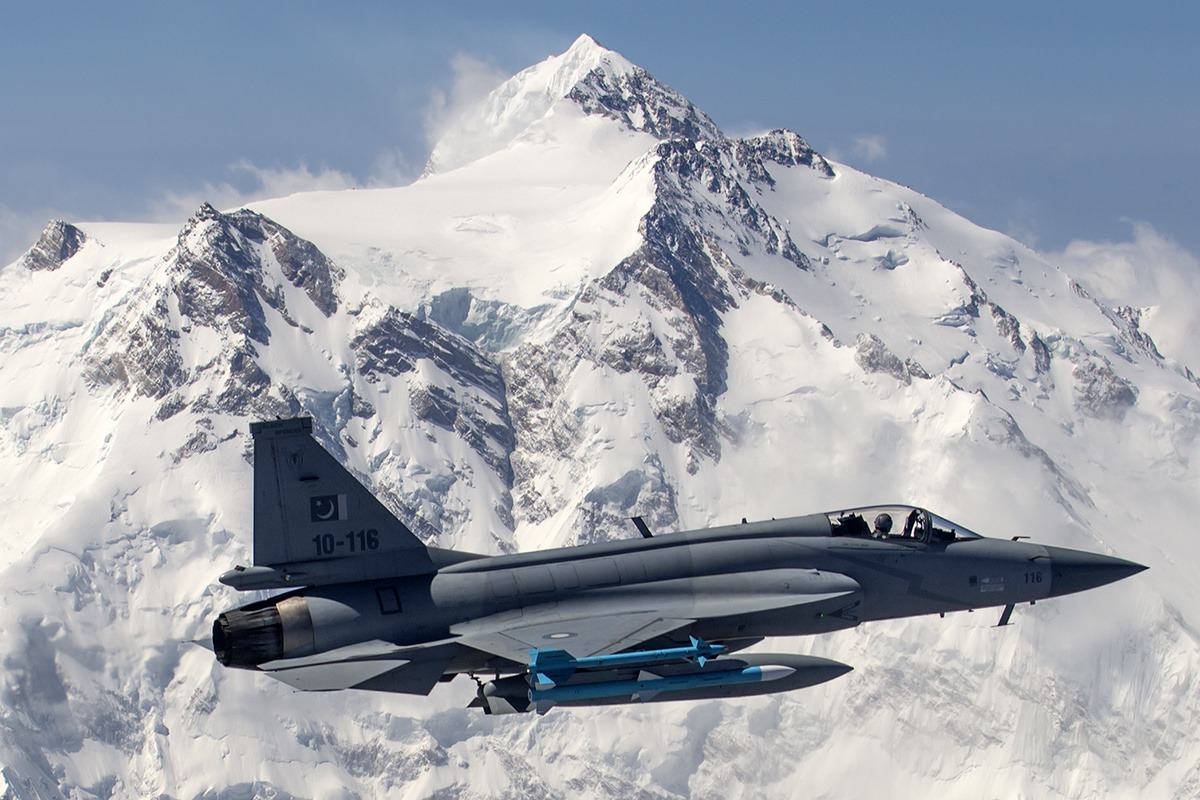Thunder Or Blunder? Pakistan’s “Cutting Edge” Fighter Meets 5th Crash In 13 Years; IAF Experts Review JF-17 Aircraft

On June 5, 2024, a JF-17 Thunder Block 2 fighter jet crashed in the Jhang district of Punjab, Pakistan. There had been a lot of social media buzz about the crash, with several videos circulating on the internet but no official confirmation from Islamabad.
While the mainstream Pakistani media and Air Force remained tight-lipped about the incident, confirmation came from unexpected quarters. On June 11, Martin-Baker, the maker of the ejection seat, took to X to confirm the news.
“On Wednesday, 5th June, a Pakistan Air Force JF-17 Block 2 aircraft crashed near the Jhang district. The pilot successfully ejected using the Martin-Baker PK16LE Seat,” the Martin Baker post read.
The JF-17 fighter is a single-engine, lightweight, multi-role combat aircraft jointly developed by the Pakistan Aeronautical Complex and China’s Chengdu Aircraft Industry Corporation. The workhorse of the Pakistan Air Force (PAF), the jet is manufactured 58% in Pakistan and 42% in China.
AfriPrime App link: FREE to download...
https://www.amazon.com/Africircle-AfriPrime/dp/B0D2M3F2JT
The JF-17 was conceived as the successor to the French and Chinese third-generation fighter jets in the Pakistani Air Force’s fleet, namely the A-5C, F-7P/PG, Mirage III, and Mirage V. As of today, the PAF has about 150 JF-17s in service; however, a significant chunk of them remain grounded, as per a report published in Sputnik India.
As per data published by the Flight Safety Foundation’s Aviation Safety Network, this is the 5th confirmed crash of the Sino-Pakistani fighter jet in its 13-year-long service. On the other hand, JF-17’s Indian counterpart, Light Combat Aircraft (LCA) Tejas, has suffered just one crash in almost eight years of service.
Problems Reported With JF-17 Thunder
-
Maintenance Problems With The Engine
Using Chinese-supplied RD-93 engines in the JF-17 is causing serious operational headaches for the PAF. As per an article published in SP’s Aviation in 2023, 40 JF-17 Block 1 and 2 fighters were grounded and categorized as un-airworthy.
Guide vanes, exhaust nozzles, and flame stabilizers had developed cracks in a substantial number of engines. As reported earlier, even the Chinese People’s Liberation Army Air Force (PLAAF) found it lacking on several fronts and did not induct it in its fleet.
In 2021, Air Marshal Anil Chopra (retired) spoke about the inferior JF-17 engine, stating that India’s LCA Tejas had a much more reliable engine than its Pakistani counterpart. Thus, the PAF and the China National Aero-Technology Import and Export Corporation (CATIC) want to substitute a Chinese RD-93 engine by sourcing it directly from Moscow. However, this shift is not as easy as it sounds.
The JF-17 Thunder uses the RD-93 engine, which is officially manufactured by Russian engine maker Klimov. After a certain number of flying hours, aircraft engines must be regularly replaced by the original equipment manufacturer (OEM).
However, such maintenance activities have become extremely cumbersome due to the strict economic sanctions imposed by the West against the original equipment supplier, ‘JSC Rosoboronexport,’ since the onset of the Russia-Ukraine conflict. Since 2018, it has been the only state-controlled firm in Russia for exports and imports of all military equipment, technology, dual-purpose goods, services, etc.
Naturally, this makes any military collaboration between Islamabad and Moscow highly undesirable for a Pakistani state already crippled by an economic crisis due to the growing fear of American sanctions.
Due to the sanctions, Rosoboronexport cannot conduct transactions in US dollars. This means complexities for the banks and the two governments in making and receiving payments and mounting maintenance costs for the Pakistani Air Force due to the country’s fast-depreciating currency.
2. Other Technical Snags and Shortcomings
According to IAF Group Captain DK Pandey’s analysis, the JF-17 is unreliable for air defense roles. Its indigenously developed Link-17 data link does not have a sufficient data transfer rate. The fighter has limited interoperability as it cannot be integrated with the Link-16 of the Pakistani F-16s.
Additionally, the jet does not have an effective Beyond Visual Range (BVR) or Airborne Interception Radar. The JF-17’s precision strike capability is also under serious doubt following the poor performance of the JF-17s during Operation Swift Retort on February 27, 2019, following effective jamming by the Indian pilot. All of PAF’s Range Extension Kit (REK) bombs failed to hit any target of significance.
Thus, the JF-17 has serious flaws such as low endurance, poor accuracy, unreliable airborne interception radar, low payload carrying capacity, maintenance problems, low credibility of aircraft main computers, and frequent failures of a number of its modules.
3. Poor Performance
To their credit, Pakistan has found many clients for its JF-17, exporting them to countries such as Nigeria and Myanmar. In addition, deals have reportedly been finalized with Azerbaijan and Iraq.
As per the Aviation Industry Corporation of China (AVIC) statement, “JF-17s were built to meet the requirements of international customers and the global market. This statement clearly shows that these fighter jets were not meant for the domestic markets but for nations that required a low-cost, multi-role, lightweight, single-engine fighter jet. It was never intended to be a state-of-the-art fighter jet but rather one that would be the cheapest option available in the category.
As reported by the Irrawaddy Times, Myanmar, the first country after Pakistan to purchase the JF-17s, was forced to ground its fleet after suffering technical malfunctions. Analysts and Former Myanmar Air Force Pilots told the news outlet that the planes have “structural cracks and other technical issues.” They added, “The aircraft, which are supposed to be capable of interception, ground attack, and bombing missions, have turned out to be unfit for service, and the Myanmar military lacks the technical expertise to fix the problem.”
They further lamented that a crucial part of the JF-17 avionics is the Chinese-made KLJ-7 AI radar, which has poor accuracy and maintenance issues. The aircraft lacks a lethal BVR missile and an airborne interceptor radar. Additionally, the malfunction of the Weapons Mission Management Computer has caused launch zones of BVR air-to-air missiles to shrink during combat exercises. According to a former Myanmar Air Force Pilot, “Furthermore, the airframe is vulnerable to damage, especially in its wingtips and hardpoints, when the aircraft encounters strong gravitational forces.”
Myanmar inked the deal with China for 16 JF-17s in 2016 at an estimated cost of $25 million each. While the first six planes were delivered in 2018, the status of the other 10 remains unclear. The first four jets were inducted into the Myanmar Air Force in December 2018 and the other 2 in December 2019. However, after nearly five and a half years since commissioning the first lot, Burmese JF-17s remain grounded.
Nigeria became the second customer of the Sino-Pak aircraft in 2016, ordering three units. Since being commissioned into the Nigerian Air Force in 2021, it has been deployed in counter-terror and insurgency operations, predominantly against Boko Haram and the Islamic State affiliate in north-eastern Nigeria.
While expectations of a fresh order were reasonably high, the Nigerian Air Force signed an agreement with Italian firm Leonardo for the purchase of 24 M-346FA aircraft that are slated to arrive in 4 batches, with the first arriving at the end of this year.
The planes, originally twin-seater jet trainers, have been modified for combat roles and will be accompanied by a 25-year logistical support package for operational efficiency and longevity. Unlike the JF-17 disaster in Myanmar, these planes have a proven track record in Italy, Israel, Qatar, Poland, and Singapore.

Positives Of JF-17 Thunder
However, despite all the criticisms of the fighter jet, the PAF seems quite confident in its operational capabilities. The latest JF-17 Block 3 version debuted at the Dubai Airshow in November 2023.
The PAF issued a statement laden with praise of the fighter. It read, “The JF-17 Thunder Block 3 fighter jet epitomizes the pinnacle of modern aerial warfare technology. Equipped with state-of-the-art avionics, enhanced weaponry, and advanced electronic warfare systems, the JF-17 Block 3 boasts superior maneuverability, extended range, and enhanced combat capabilities. Its participation in the Dubai Airshow signifies PAF’s confidence in this Indigenous marvel, highlighting Pakistan’s commitment to fostering self-reliance in the defense industry.”
The JF-17 Block 3 has been described as a “fourth-generation plus” by PAF officials. This latest version of the fighter jet was inducted into the PAF in November 2023. As reported by EurAsian Times earlier, this variant comes with “superior maneuverability, extended range, and enhanced combat capabilities.”
Additionally, it comes with better stealth features, such as a reduction in the aircraft’s radar cross-section, resulting from the greater use of composites and better avionics. This version will be equipped with the active electronically scanned array (AESA) radar.

The radar system is the Nanjing Research Institute of Electronics Technology (NRIET) KLJ-7A X-band airborne 3D fire control radar (FCR). Its predecessor in the Block 2 variant, the KLJ-7 V2 radar, can detect any aircraft with a radar cross-section of 3 meters at a maximum range of 150 km.
The latest version is said to have better multi-targeting capability, increased resilience to jamming, easier maintenance, and increased range. It is said that by the end of 2024-2025, Pakistan will have 50 of this superior Block 3 variant, making them a sizeable threat.
Additionally, in 2021, the Chinese state-run daily tabloid, the Global Times, stated that the JF-17 fighter would be paired with China’s most advanced air-to-air combat missile, i.e., the PL–10, a missile used in China’s 5th generation J-20 fighter jet.
Quoting an unnamed military expert in Beijing, the Global Times wrote, “With the PL-10, the JF-17 Block 3 will gain tremendous dogfight capability and have an edge even against its heavier opposing counterparts in homeland air defense.”
Senior Indian defense analyst Abhijit Iyer Mitra, a senior fellow at the Institute of Peace and Conflict Studies, New Delhi, has heaped praise on the JF-17 on various occasions. Speaking on the popular YouTube channel ‘The Jaipur Dialogues, ’ he stated that even the JF-17 Block 1 would be better than Tejas MK 3.
Additionally, on another popular YouTube channel named ‘Abhinav Prakash,’ he added that the JF-17’s low cost has made the PAF believe that they will be able to throw a large number of them into the battlefield and eventually take down even the much superior Indian Rafales, relying on the quality-quantity paradigm.
In an earlier interaction with Mitra had highlighted the positives of the JF-17, opining that it slots into the Chinese supply chain and has a huge variety of proven and demonstrable weapons. Further, he added that whatever upgrades the plane has seen are “solid and proven.”
AfriPrime App link: FREE to download...
- Questions and Answers
- Opinion
- Story/Motivational/Inspiring
- Technology
- Art
- Causes
- Crafts
- Dance
- Drinks
- Film/Movie
- Fitness
- Food
- Παιχνίδια
- Gardening
- Health
- Κεντρική Σελίδα
- Literature
- Music
- Networking
- άλλο
- Party
- Religion
- Shopping
- Sports
- Theater
- Wellness
- News
- Culture
- War machines and policy

